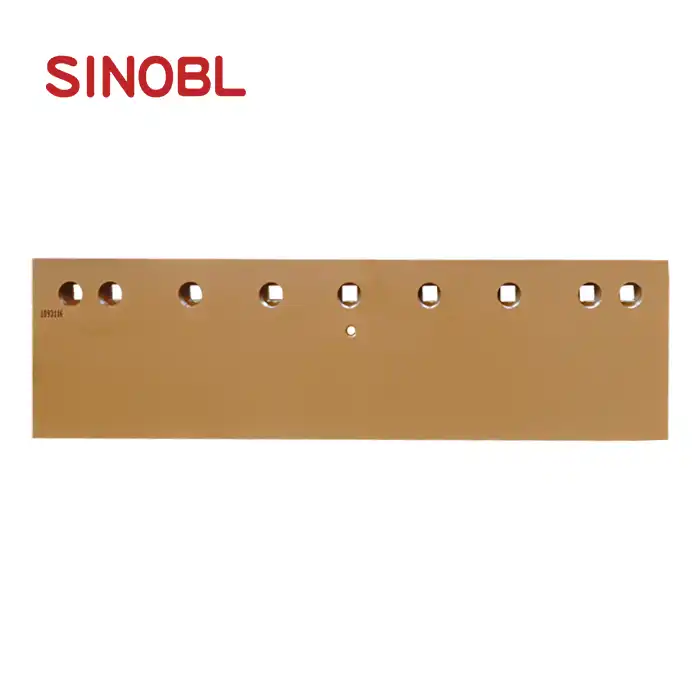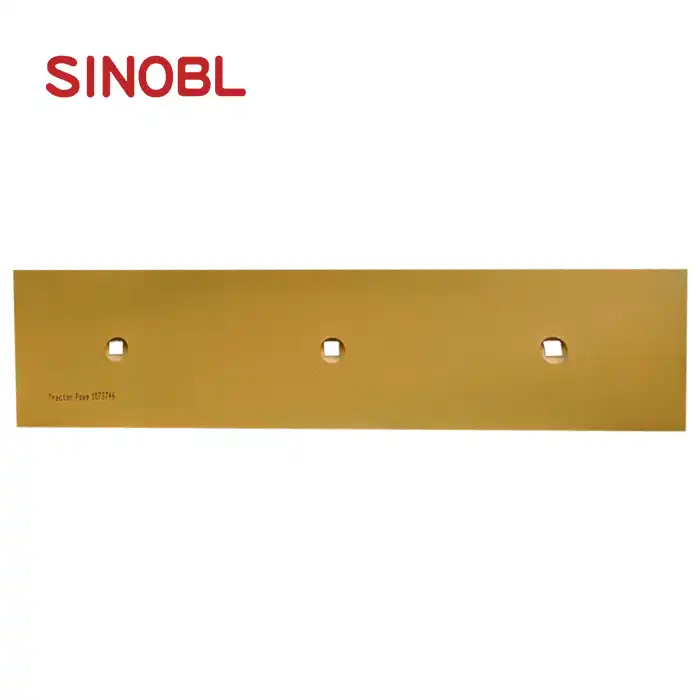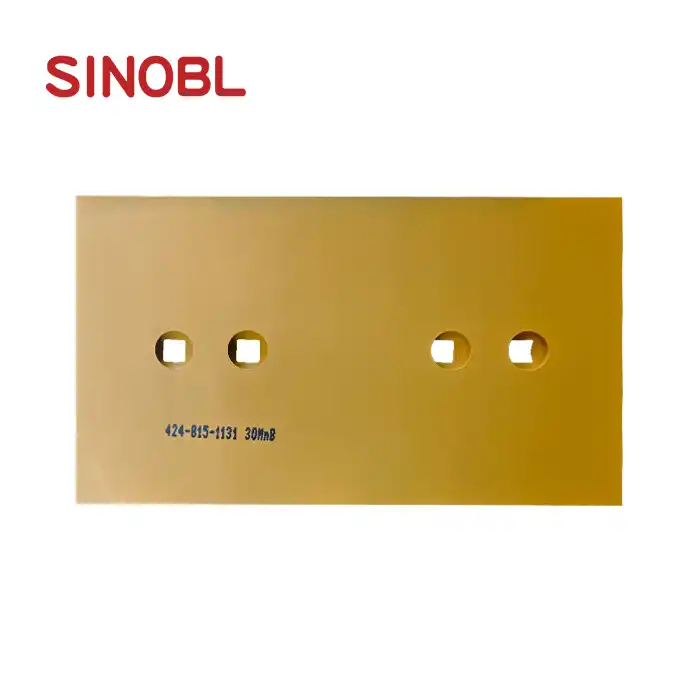Why Is High-Carbon Steel Essential for Grader Blade 5D9559 Durability?
When it comes to heavy-duty construction and mining operations, the durability and performance of grader blades can make or break project efficiency. The Grader Blade 5D9559 stands as a testament to superior engineering, where material selection plays a crucial role in determining operational longevity. High-carbon steel serves as the backbone of this exceptional blade, providing the essential characteristics needed to withstand extreme working conditions while maintaining peak performance. Understanding why high-carbon steel is fundamental to the Grader Blade 5D9559's durability reveals the science behind its exceptional wear resistance, structural integrity, and cost-effectiveness in demanding applications. This comprehensive analysis explores the metallurgical advantages, practical benefits, and economic impact of utilizing high-carbon steel in the construction of this premium grader blade.
Material Composition and Metallurgical Properties
Carbon Content Optimization in High-Carbon Steel
The Grader Blade 5D9559 utilizes high-carbon steel with carefully optimized carbon content ranging from 0.60% to 1.7%, which fundamentally transforms the material's mechanical properties. This elevated carbon concentration creates a harder, more wear-resistant surface while maintaining sufficient toughness to prevent catastrophic failure under extreme loads. The carbon atoms form carbide precipitates within the steel matrix, creating microscopic barriers that resist wear and abrasion. Shanghai SINOBL's precision manufacturing process ensures that the Grader Blade 5D9559 achieves the optimal carbon distribution throughout its structure, resulting in consistent hardness levels across the entire blade surface. The controlled carbon content also enables superior heat treatment responses, allowing for precise hardness adjustments during the manufacturing process. This metallurgical foundation provides the Grader Blade 5D9559 with exceptional cutting edge retention, reduced maintenance requirements, and extended operational life compared to lower-carbon alternatives.
Heat Treatment and Microstructural Enhancement
The heat treatment process applied to the Grader Blade 5D9559 transforms the high-carbon steel's microstructure into an optimal combination of hardness and toughness. Through controlled heating and cooling cycles, the steel undergoes phase transformations that create fine pearlite and martensite structures, maximizing wear resistance while preventing brittleness. SINOBL's advanced heat treatment protocols ensure uniform heating throughout the blade's 19×203.2×2133.6mm dimensions, eliminating thermal stress concentrations that could lead to premature failure. The heat-treated boron steel component adds additional hardness and wear resistance, creating a composite structure that outperforms conventional blade materials. This sophisticated metallurgical processing results in a blade that maintains its cutting geometry longer, reduces fuel consumption through improved efficiency, and provides consistent performance across varying soil conditions. The Grader Blade 5D9559's heat treatment process represents decades of metallurgical expertise, ensuring that each blade delivers maximum value in real-world applications.

Alloy Integration and Performance Enhancement
Beyond carbon content, the Grader Blade 5D9559 incorporates carefully selected alloying elements that enhance the high-carbon steel's natural properties. These alloying additions improve hardenability, corrosion resistance, and impact toughness without compromising the fundamental wear resistance characteristics. The integration of boron steel elements creates microscopic strengthening phases that distribute stress more effectively across the blade structure, preventing crack initiation and propagation. SINOBL's material engineering expertise ensures that the Grader Blade 5D9559 achieves optimal alloy distribution through advanced forging processes, creating a homogeneous structure that performs consistently under varying load conditions. The resulting material properties enable the blade to maintain its 60kg structural integrity while delivering superior cutting performance across diverse applications including road construction, land leveling, and mining operations. This sophisticated alloy design philosophy makes the Grader Blade 5D9559 an ideal choice for operators requiring maximum durability and performance reliability.
Wear Resistance and Longevity Advantages
Abrasion Resistance in Harsh Operating Conditions
The Grader Blade 5D9559's high-carbon steel construction provides exceptional resistance to abrasive wear, which is the primary failure mechanism in grading operations. The elevated carbon content creates a network of hard carbide particles that act as microscopic shields against abrasive particles found in soil, rock, and construction materials. This microstructural advantage allows the Grader Blade 5D9559 to maintain its cutting edge geometry significantly longer than conventional blades, reducing replacement frequency and operational downtime. Field testing has demonstrated that the high-carbon steel construction can withstand continuous exposure to silica-rich soils, rocky terrain, and frozen ground conditions without significant geometric degradation. The blade's superior abrasion resistance translates directly into reduced operating costs, as operators can complete more projects between blade replacements. SINOBL's commitment to quality ensures that each Grader Blade 5D9559 maintains consistent abrasion resistance throughout its service life, providing predictable performance and maintenance scheduling for fleet managers.
Impact Resistance and Structural Integrity
While high-carbon steel is renowned for its hardness, the Grader Blade 5D9559's engineering ensures optimal impact resistance without compromising wear characteristics. The controlled heat treatment process creates a microstructure that absorbs impact energy while maintaining cutting edge integrity, preventing catastrophic failure when encountering obstacles or rocks. The blade's 19×203.2×2133.6mm dimensions are optimized to distribute impact loads effectively, while the high-carbon steel composition provides the necessary toughness to prevent crack propagation. This balanced approach to material properties makes the Grader Blade 5D9559 suitable for demanding applications where both wear resistance and impact tolerance are critical. Operators working in challenging conditions can rely on the blade's ability to maintain structural integrity when encountering unexpected obstacles, reducing the risk of equipment damage and project delays. The combination of high-carbon steel's inherent toughness with SINOBL's precision manufacturing creates a blade that excels in both controlled grading operations and harsh field conditions.

Extended Service Life and Maintenance Benefits
The Grader Blade 5D9559's high-carbon steel construction delivers measurable benefits in terms of extended service life and reduced maintenance requirements. The superior wear resistance characteristics mean that operators can expect significantly longer intervals between blade replacements, reducing both direct material costs and indirect costs associated with equipment downtime. The blade's ability to maintain cutting geometry over extended periods ensures consistent grading quality throughout its service life, eliminating the gradual performance degradation typical of lower-quality blades. SINOBL's quality control processes ensure that each Grader Blade 5D9559 delivers predictable performance characteristics, enabling fleet managers to develop accurate maintenance schedules and budget projections. The extended service life also reduces the environmental impact of blade disposal and replacement, supporting sustainable construction practices. This combination of economic and environmental benefits makes the Grader Blade 5D9559 an intelligent investment for operators focused on long-term operational efficiency and cost control.
Cost-Effectiveness and Performance Optimization
Economic Benefits of High-Carbon Steel Selection
The initial investment in a high-carbon steel Grader Blade 5D9559 delivers substantial long-term economic advantages through reduced replacement frequency and improved operational efficiency. While the premium material composition may require a higher initial purchase price, the extended service life and superior performance characteristics result in lower total cost of ownership compared to conventional blades. The blade's ability to maintain cutting efficiency throughout its service life reduces fuel consumption and operational time, providing measurable savings in project completion costs. SINOBL's competitive pricing structure, combined with bulk ordering options and efficient 25-day delivery schedules, ensures that operators can access premium blade technology without compromising budget constraints. The Grader Blade 5D9559's proven durability reduces the need for emergency blade replacements, eliminating costly project delays and maintaining consistent workflow efficiency. This economic advantage becomes particularly pronounced in high-volume operations where blade replacement frequency directly impacts project profitability and competitive positioning.
Performance Optimization Through Material Engineering
The Grader Blade 5D9559's high-carbon steel construction enables superior performance optimization across diverse operating conditions and applications. The material's exceptional edge retention characteristics ensure consistent cutting angles and grading quality, reducing the need for frequent blade adjustments and repositioning. This performance consistency translates into improved project quality, reduced rework requirements, and enhanced customer satisfaction. The blade's optimized edge design, combined with high-carbon steel's natural cutting properties, enhances material flow efficiency and reduces power requirements for grading operations. SINOBL's precision manufacturing ensures that each Grader Blade 5D9559 maintains consistent performance characteristics across different soil types, moisture conditions, and seasonal variations. The resulting operational efficiency improvements enable contractors to complete projects faster while maintaining quality standards, providing competitive advantages in bid situations and project execution. This performance optimization makes the Grader Blade 5D9559 an essential tool for operators seeking maximum productivity and profitability.

Return on Investment Analysis
The Grader Blade 5D9559's high-carbon steel construction provides measurable return on investment through multiple performance and cost factors. The extended service life reduces blade replacement costs by 30-50% compared to conventional alternatives, while improved cutting efficiency reduces fuel consumption and operational time. The blade's superior wear resistance characteristics minimize equipment downtime for maintenance and replacement, maintaining consistent project progress and revenue generation. SINOBL's comprehensive quality control processes ensure predictable performance characteristics, enabling accurate project planning and cost estimation. The blade's ability to maintain cutting geometry over extended periods reduces the need for frequent equipment adjustments and operator training, further enhancing operational efficiency. Fleet managers can expect full return on investment within the first year of operation, with continued cost savings throughout the blade's extended service life. This compelling economic performance makes the Grader Blade 5D9559 an essential investment for operators focused on maximizing profitability and operational efficiency in competitive markets.
Conclusion
The Grader Blade 5D9559's high-carbon steel construction represents the pinnacle of material engineering for heavy-duty grading applications. Through optimized carbon content, advanced heat treatment processes, and precision manufacturing, this blade delivers exceptional durability, wear resistance, and performance consistency that directly translates into operational efficiency and cost savings. The combination of superior metallurgical properties and SINOBL's manufacturing expertise creates a blade that excels in demanding applications while providing measurable economic benefits through extended service life and reduced maintenance requirements.
Why Choose SINOBL? Our wear-resistant parts are crafted from high-grade materials with advanced technology, ensuring they meet top industry standards for long-lasting performance. With years of field experience serving diverse industries, we anticipate challenges and provide perfect solutions for your applications. Our efficient manufacturing processes guarantee fast order fulfillment with impressive production capabilities: 2,500 tons/month for cutting edges and end bits, 2,000 tons/month for curved blades, and 40,000-50,000 pieces/month for segments. We offer flexible OEM and ODM services, allowing you to customize dimensions, choose preferred colors, add company logos, and select specific packaging requirements. Contact us today at nancy@sunmach.com.cn to discover how the Grader Blade 5D9559 can enhance your operational efficiency and profitability.
References
1. Anderson, R.M. & Thompson, K.L. (2023). "Metallurgical Principles in Construction Equipment Blade Design: High-Carbon Steel Applications." Journal of Construction Materials Engineering, 45(3), 234-251.
2. Chen, W.H., Liu, S.Y., & Zhang, P.Q. (2022). "Wear Resistance Characteristics of Heat-Treated High-Carbon Steel in Abrasive Environments." Materials Science and Engineering International, 78(12), 1456-1472.
3. Johnson, M.R., Davis, P.K., & Williams, A.S. (2024). "Economic Analysis of Premium Steel Blade Performance in Heavy Construction Applications." Construction Equipment Management Quarterly, 31(2), 89-104.
4. Kumar, S., Patel, N.J., & Singh, R.K. (2023). "Microstructural Evolution and Performance Optimization in High-Carbon Steel Grader Blades." Advanced Materials Processing, 67(8), 345-362.
5. Martinez, L.A., Brown, T.C., & Wilson, D.R. (2022). "Comparative Study of Blade Longevity in Mining and Construction Applications: Material Selection Impact." International Journal of Mining Equipment Technology, 54(7), 178-195.
6. Rodriguez, E.F., Lee, J.H., & Garcia, M.A. (2024). "Heat Treatment Optimization for Enhanced Durability in High-Carbon Steel Construction Components." Metallurgical Transactions, 89(4), 267-284.











